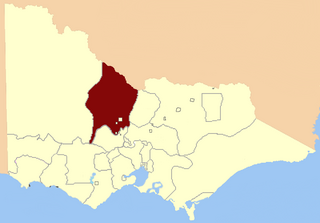
William Clark Haines, Australian colonial politician, was the first Premier of Victoria.

Sir John Bowser, Australian politician, was the 26th Premier of Victoria. He was born in London, the son of an army officer, and arrived in Melbourne as a child with his family. He grew up at Bacchus Marsh and when he left school got a job with the Bacchus Marsh Express. As a young man he went to Scotland and worked on newspapers while studying at Edinburgh University. Returning to Australia, he settled in Wangaratta, where he farmed and managed the Wangaratta Chronicle, which he eventually bought.

The electoral district of Melbourne is an electorate of the Victorian Legislative Assembly. It currently includes the localities of Carlton, North Carlton, Melbourne, East Melbourne, West Melbourne, North Melbourne, Parkville, Newmarket, Kensington and Flemington, and includes Melbourne University. The district has been in existence since 1856.
The Electoral district of Wangaratta was an electoral district of the Victorian Legislative Assembly. It was created in the redistribution of 1904, the Electoral district of Wangaratta and Rutherglen being abolished.
The Solicitor-General of Victoria, Australia is the state's Second Law Officer, behind the Attorney-General. The holders of this office are appointed by Cabinet on the basis of their legal expertise. Solicitors-General are members of the Executive. Formerly, they were elected members of parliament, but have not been so since the early/mid twentieth century.
This is a list of members of the Victorian Legislative Assembly as elected at the 26 June 1924 state election and subsequent by-elections up to the general elections of 9 April 1927:

Collingwood was an electoral district of the Legislative Assembly in the Australian state of Victoria from 1856 to 1958. It centred on the Melbourne suburb of Collingwood, Victoria.

Loddon was an electoral district of the Legislative Assembly in the Australian state of Victoria from 1856 to 1859. It was based in northern Victoria around the Loddon River.

The Murray was an electoral district of the Legislative Assembly in the Australian colony of Victoria from 1856 to 1877.

Murray Boroughs was an electoral district of the Legislative Assembly in the Australian state of Victoria from 1856 to 1877. It was based in northern Victoria, and included the towns of Benalla Avenel Euroa Seymour, Wodonga and Wangaratta. The district of Murray Boroughs was one of the initial districts of the first Victorian Legislative Assembly, 1856.

The Electoral district of Murray was one of the sixteen electoral districts of the original unicameral Victorian Legislative Council of 1851 to 1856.

Sandhurst was an electoral district of the Legislative Assembly in the Australian state of Victoria from 1856 to 1904. It was based on the towns of Sandhurst (now Bendigo) and Lockwood.

The Electoral district of Grant was one of the sixteen electoral districts of the original unicameral Victorian Legislative Council (Australia) of 1851 to 1856.

Geelong East was an electoral district of the Legislative Assembly in the Australian state of Victoria from 1859 to 1985. It was located south of the city of Geelong, defined in the Victorian Electoral Act, 1858 as:
Commencing at the north-western angle of the town reserve of Geelong; thence by a line south to the River Barwon; thence westward and northwestward by the River Barwon to the western boundary of the reserve at the junction of the Moorabool and Barwon; thence east by the northern boundary of section 25, parish of Barrabool; thence south by the eastern boundaries of sections 25 and 11, and by part of the eastern boundary of section 7, all in the same parish; thence south-easterly by a curved line crossing the Waurn Chain of Ponds to the southern boundary of section 3, parish of Conewarre; thence east by the southern boundaries of sections 3 and 4 in the same parish; thence north-easterly by a curved line crossing the River Barwon to the south-eastern angle of section 11 in the parish of Moolap; thence by the eastern boundary of that section and a line north to the shores of Corio Bay; and thence by the shores of Corio Bay to the north-western angle of the town reserve, the commencing point aforesaid, including the remaining portion of the reserve at Point Henry.

The Electoral district of Ovens was an electoral district of the old unicameral Victorian Legislative Council of 1851 to 1856. Victoria being a colony in Australia at the time. Ovens was added to the Council in 1855, along with four other districts.

The Electoral district of Wimmera was one of the original sixteen electoral districts of the old unicameral Victorian Legislative Council of 1851 to 1856. Victoria was a colony in Australia at the time.

This is a list of members of the Victorian Legislative Council, as appointed to the Council of 1853 or elected at the 1853 election. Members added in 1855 are noted in a separate section below.

This is a list of members of the Victorian Legislative Council from the elections on 5 August 1856 to the elections of 31 August to 2 October 1858.
Daniel Cameron was an miner and politician in colonial Victoria, a member of the Victorian Legislative Council and later, the Victorian Legislative Assembly.
Alfred Arthur Billson was an Australian politician.















